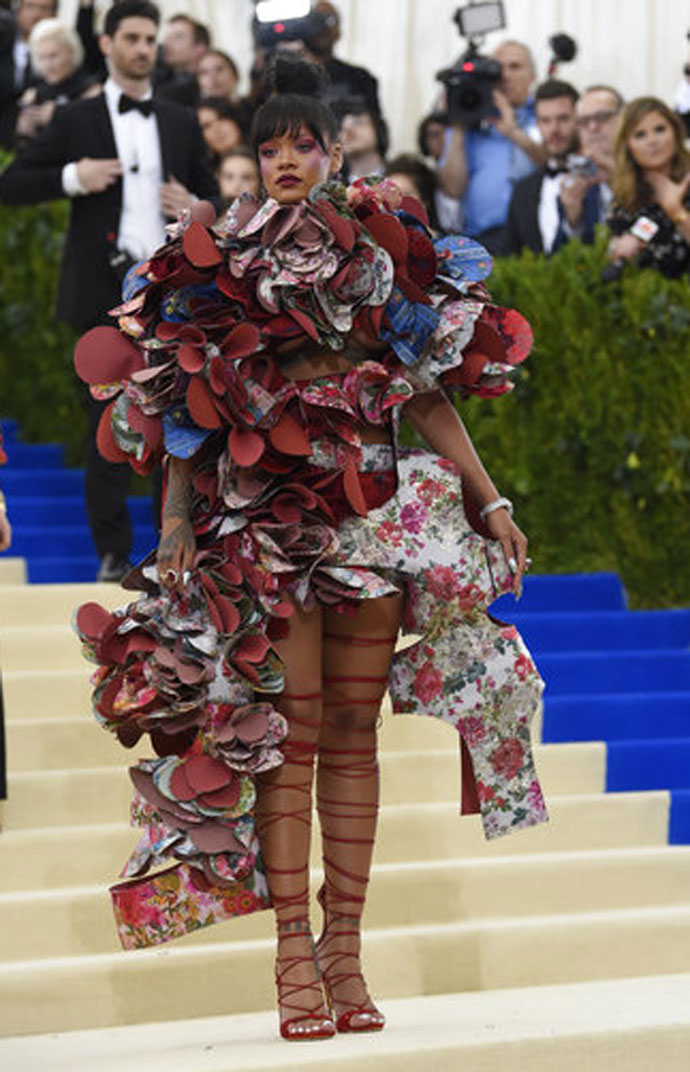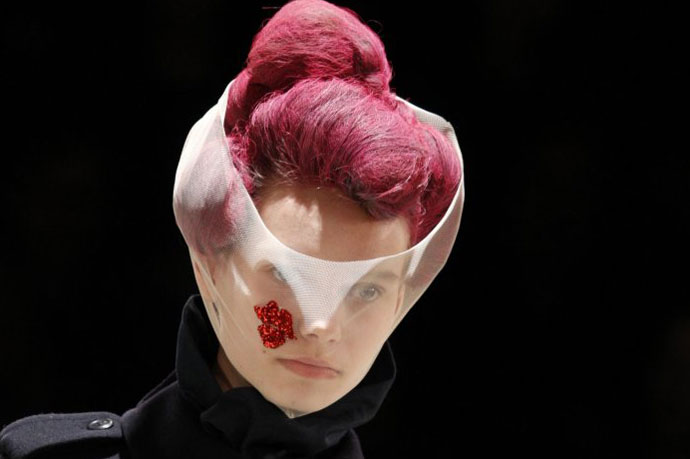Met Gala 2017: Why no ode is enough to define designer Rei Kawakubo

"I want to be forgotten."
- Rei Kawakubo
It’s courage to be wanting to be forgotten. And in wanting to be forgotten, there’s an embrace with the void. There’s also freedom from the baggage of past and future. Rei Kawakubo is a poet of the dark underworld, a spark trying to ignite fires long dead, a dangerous artist. She is the goddess uninterrupted. She is Persephone, the wanderer of the underworld. She imagines what lovers can’t — the garden of emptiness, the forbidden fruits of abandonment and despair.
What is it then? What makes her so?
Guilt? Terror? The fear of rejection? The fear of love? The emptiness of abandonment and the despair of loneliness?
Each time, I see Kawakubu’s collections, I am reminded of the Countess in Angela Carter’s The Lady of the House of Love. The story is about unreason, a dark room, which turns out to be cheap and tacky in the golden sunshine, a caged lark, a virgin Englishman and a garden full of roses and the vampire, who is a genius of sadness.

Carter implies that the Countess’ beauty is a symptom of her disorder, of her soulessness. But when she is transformed, her face looks "far older" and "less beautiful" and for the first time fully "human" after her supernatural world of torment collapses and the caged lark, at first hesitant to fly out into the sky, escapes the castle.
Kawakubo’s tryst with transformations is what is most intriguing. She can’t be stopped. She won’t stop until she has dealt with the disorders of beauty, of the ephemeral and of a world of monsters and witches, who the designer channelises as muses.
In the story of the Countess, she gives a "fanged rose" plucked from between her thighs. The red rose portrays the “Countess' inability to experience pleasure” and she describes the rose "like a flower laid on a grave", but the rose is still alive when the Englishman takes it home to the barracks. This is important.
It implies there is still room for the irrational and unexplainable in the world and this is what makes Kawakubo a seductress like the Countess herself. She tempts us into the netherworld. Kawakubo who has said that without unhappiness there can be no art. She herself is a genius of sadness. And sadness isn’t a bad thing. She isn’t in denial like others that are creating frills and lace and things of beauty in a bid to escape the world at large. Not her. She is immersing herself in it, penetrating the void to create a new language. She is at once formless and all about forms. And because we live in a post-truth and post-gender world, her no-sexualised idea of clothing appealed as the most liberating concept.
The Countess wore the same wedding gown that belonged to her mother everyday. Kawakubo is always dressed in black. I have always wanted a paranormal dress, a gift to myself. A dream is a gift. It is a secret almost if you can remember it.
There is a story about Kawakubo. She had removed the mirrors. She was interested in what a dress felt like, not looked like. I don’t have many mirrors in my house. In my early 30s, I understood through charts and theories that mirrors reflected the “inverse image” and I couldn’t fathom why we obsessed with how we looked because the closest we could come to seeing ourselves would be an inverse reflection. It didn’t make sense. I was in love with how she named her collections — Ceremony of Separation, Blue Witches, etc.
***

She called them “Blue Witches”. Their head was flaming red and chaotic. They walked about in defiance of the body in cocoon-shaped silhouettes that paid no homage to vanity or the form. They weren’t social animals as witches shouldn't be, but as Virginia Woolf once wrote in her famous A Room of One’s Own that when one reads of a witch being ducked, then she thinks “we are on the track of a lost novelist, a suppressed poet, of some mute and inglorious Jane Austen, some Emily Bronte who dashed her brains out on the moor or mopped and mowed about the highways crazed with the torture that her gift had put her to. Indeed, I would venture to guess that Anon, who wrote so many poems without signing them, was often a woman".
I am going to call Kawakubo a near poet, a suppressed novelist. She is a woman isn't afraid to be us — the witches. Of course, she has gone past the gender tags. That's the first step.
In Spring 2016, she called her collection "Blue Witches". Ray Bradbury once wrote that a witch is born out of the true hungers of her time. So are we. So is she, who has defied fashion. Her clothes are abstraction. But abstraction isn't isolation. So, if there is a bulbous outfit with no scope for movement of hands, it could be that she is hinting at the unfreedom of our times.
The high priestess of fashion Anna Wintour cold-shouldered her, but Kawakubo collapsed vanity. The designer collapses notions of beauty itself.
I have often wanted to ask her why she walks through the woods alone? Or what does Kawakubo dream of?
But in her case, autobiography is not important. It is her work that must speak for herself. And although there could be exposure in the creative process, a certain kind of vulnerability even, it is not always a confessional. Kawakubo has barely spoken about her life. But she has always called the pain real.
And for years the elusive, inscrutable and reticent Rei Kawakubo has spoken of pain and the exercise in suffering that makes her a traveller into the future. She isn’t a nostalgist. A journalist once said that she is trying to measure infinity. She won't look back. Past can't trap her. The future is an open space.
She isn't afraid of empty spaces.
Her medium is subversion. She can subvert anything. Even a tumor. Even death. Even the business of beauty. Perhaps the bulbous pattern cutting is an effort to freeze tears, which Samuel Beckett, the writer of voids, said are a constant in this world. Or, maybe it is to demonstrate language’s futility.
***
Everything was an exercise in suffering. The tumors, the abstract flowers of some imagined landscape where monsters and fairies lived that only a child could draw because it had that freedom, the strangeness of costumes that didn't cater to arms or limbs or for that matter, even vanity. That in itself is liberating.
Kawakubo's address to emptiness is a visual ode to void. She stretches time itself. She races against it. She twists it. She celebrates emptiness and imperfections. She redefines asymmetry to the point where you don't find alignment tantalising anymore. Chaos is her medium. But her work has embedded elements, stories, myths.
For instance, I am reminded of the myth of Atlas, who led a failed rebellion against the gods of Olympus and was condemned to carry the weight of the earth and the heavens forever, when I see the models walk gracefully in Kawakubo’s collections. She is free in her orbit.
In fact, it could be that nothingness is a heavy burden to carry and that future only hardens everyday when you are trying to disengage from the past.
In her own words, she wasn’t even trying to make clothes in Spring/Summer 2014 which she called “Not Making Clothes”.
I am not a design student. I am not even a fashion influencer. I am a writer, and Kawakubo is an artist.
Like writers, she is in and out of many lives, she takes on identities, and like David Bowie who created an alternate ego in "Ziggy Stardust", Kawakubo “craved an alternate consciousness, any consciousness as long as it wasn’t hers: outsider artists, autistics, schizophrenics, psychonauts…” and she was forever mapping her way out of her own head, which is what any creative process is like.
Writers are betrayers who rely on the art of subversion. So does Kawakubo. She would make you want to defy gravity even. In fact, she has rejected the gravitational pull of the past to stay in her present.
The in-between space is painful. It is painful to write, to create and to not give in. Kawakubo knows this.
She has denied the past except when she agreed for a retrospective at the Met Gala. With Rei, the possibilities are boundless. She won't even succumb to the temptations of the body. She won't look back. She had once wanted a career that could give her pain and suffering. In wanting to be forgotten, there is also an admission of that permanent hold of memory.

She was born in Japan and started as stylist and couldn’t find the kind of clothes she wanted to use for her projects. So, she started creating them and then opened her store. Later, she came up with the concept of guerrilla stores. Comme des Garcons is an institution, an almost version of Anti-Christ, but that is if you took Chanel and Gucci’s perfect fantasy fairy lands and flowers as the other spectrum.
Kawakubo’s lab is hell itself where the only driving force is pain, a prolonged sense of trying to break away and keep creating new things that don’t emerge from the oeuvre of her own body of work.
The children of Comme des Garçons were all pattern makers because to create something new, to catch hold of a moment of personal values, to express outrage and to to express void, you have to be able to cut, dismember, deconstruct and reconfigure a new world.
Her clothes are ideas.
To confront memory in a museum could be painful especially if you were that woman called Kawakubo, who is forever dismantling and mercilessly so and moving on. Museums are mausoleums unless you were a nostalgist or a memoirist. The designer has often said fashion isn't art. She doesn't bother with interpretations or explanations.
You can affix meanings, even movements to what she has created. But remember that Kawakubo has said repeatedly that she was battling to create something new and beautiful doesn't have to be pretty. And monsters weren't necessarily ugly, she says.

Though it covers her 35 years of work, the designer hadn’t wanted the exhibition as a “retrospective".
It’s the Met Gala in New York, the most fashionable of all places where fashionistas walk in gowns that could cover an entire field with their trail, and Kawakubo was there as the second living designer to have an exhibition in her customary black and bob and her fixed expression. But that’s incidental.
That it is called the Art of the In-Between is not. The roses of the Countess are still around refuting rationality. The monsters are victims, too. The witches are powerful beings. But often misunderstood.
And that's why to understand Kawakubo, one must see her as Persephone, the wanderer, and as a poet. Fashion world with its Wintours and others are not references enough.

